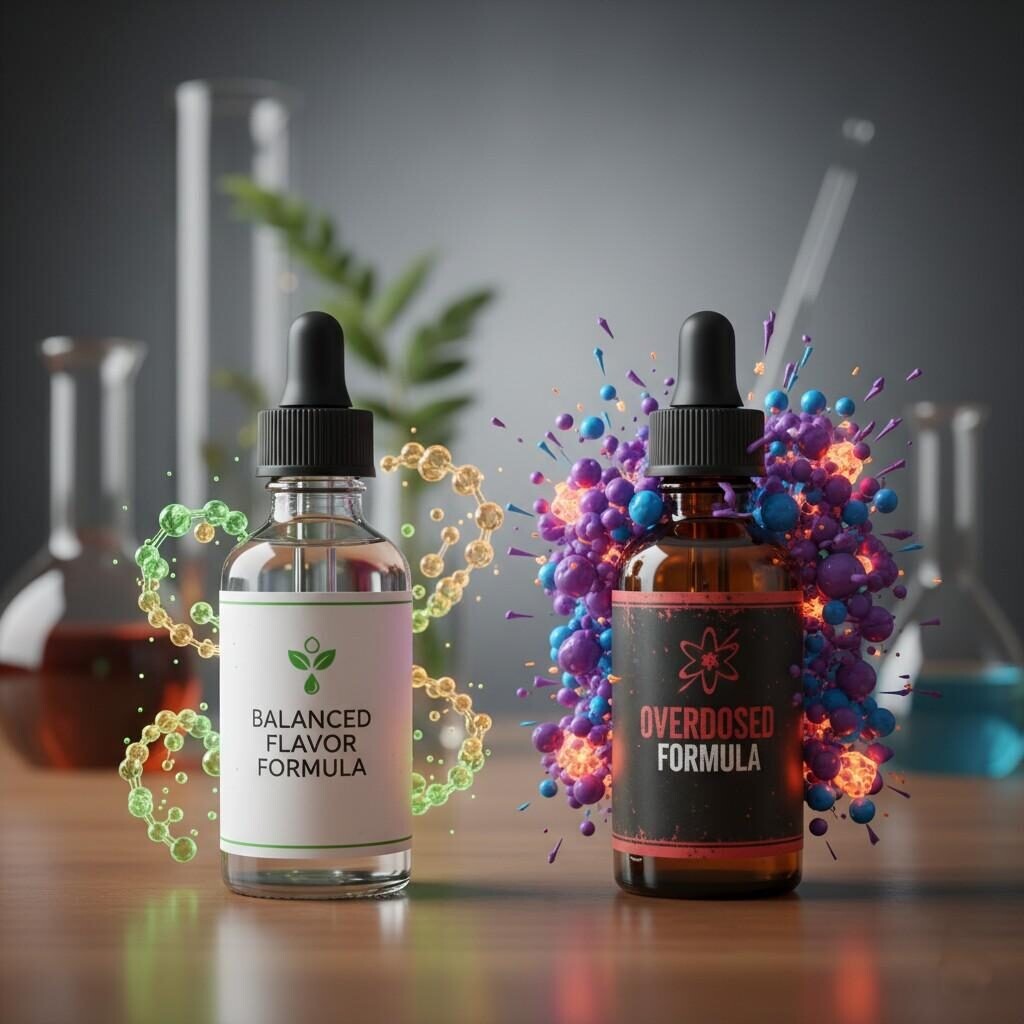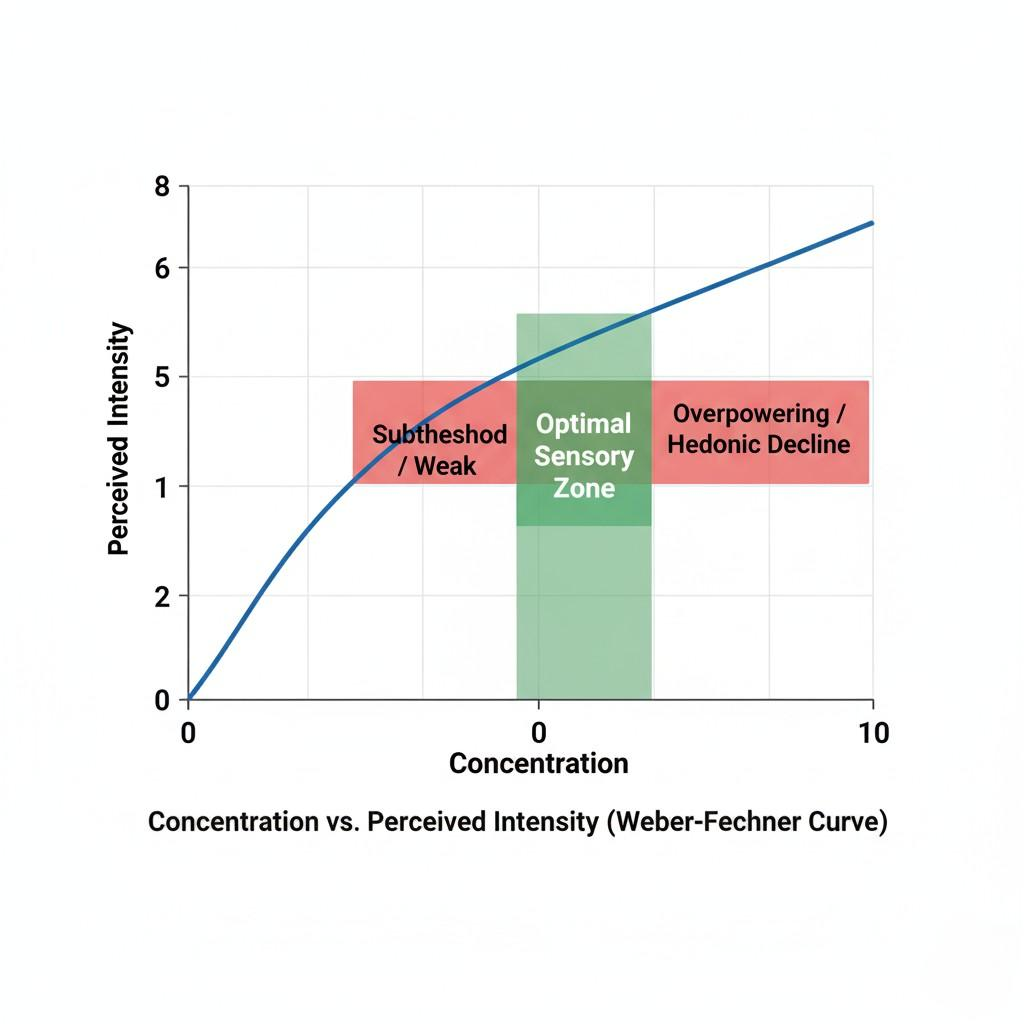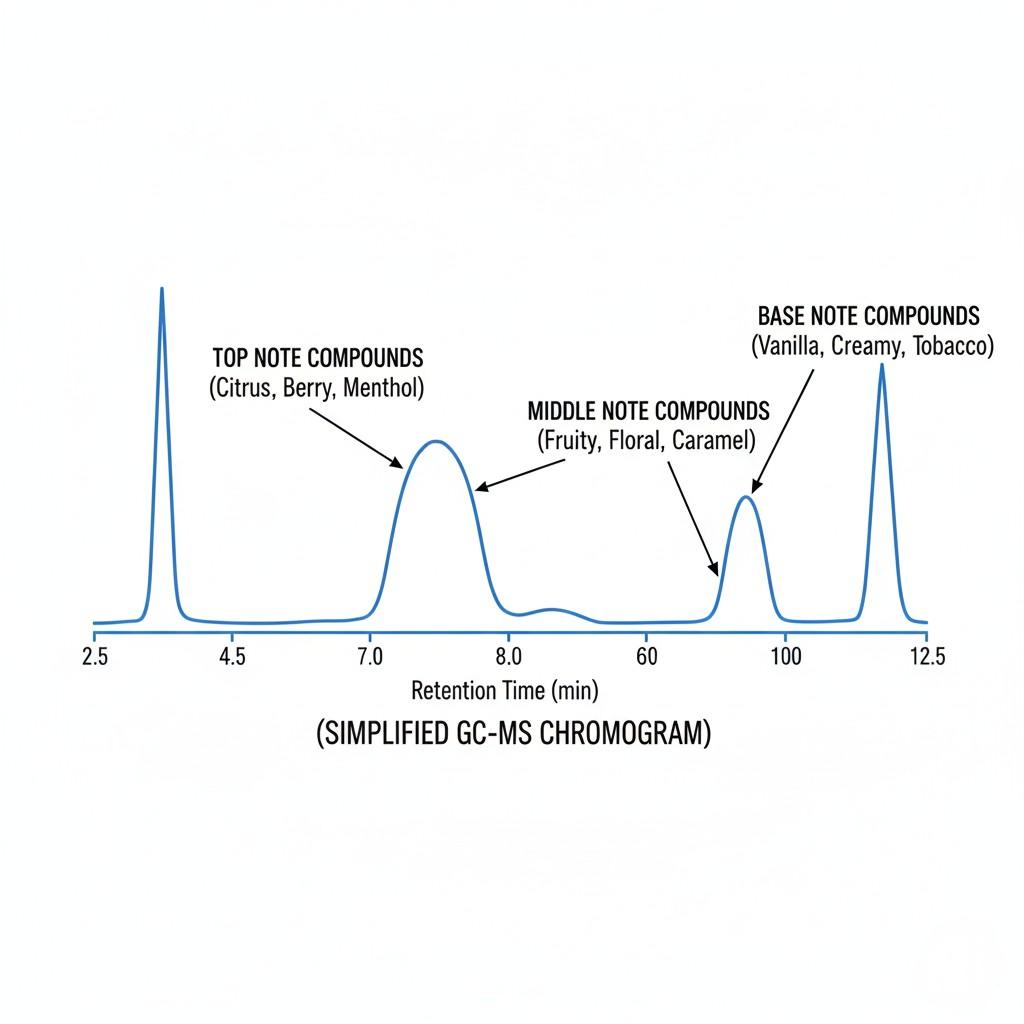Author: R&D Team, CUIGUAI Flavoring
Published by: Guangdong Unique Flavor Co., Ltd.
Last Updated: Oct 25, 2025

Flavor Balance vs. Overload
In the competitive world of e-liquid formulation, flavor intensity often becomes a symbol of quality — or at least, that’s the common perception. Many brands and DIY mixers assume that doubling or tripling the flavor concentration will automatically result in a richer, more satisfying taste. But as flavor scientists know, the chemistry of perception doesn’t work that way.
Excessive use of flavor compounds can distort sensory balance, create off-notes, accelerate degradation, and even pose regulatory or safety risks. This is known in the flavor industry as the “overdosing myth.”
In this article, we will explore the science behind flavor concentration, the sensory and chemical consequences of overdosing, and how professional flavor manufacturers like CUIGUAI Flavoring design concentrated yet balanced e-liquid aromas.
We’ll uncover how to achieve impactful flavor — without going overboard.
Flavor is not merely the sum of chemical compounds added to a formula; it’s the result of a complex sensory interaction between taste, smell, and trigeminal sensations (cooling, warming, tingling). According to the Monell Chemical Senses Center, human sensory perception follows a logarithmic response — meaning doubling concentration does not double perceived intensity.
Instead, perception follows a Weber-Fechner curve, where small increases are noticeable only up to a threshold. Beyond that, perception plateaus or even declines due to sensory adaptation.
Citation 1: Monell Chemical Senses Center. (n.d.). Understanding Taste and Smell: The Science of Sensory Perception. Retrieved from https://monell.org
When flavor levels exceed optimal sensory thresholds, several problems emerge:
Thus, the goal of expert formulators is not to maximize dosage, but to engineer synergy and clarity.
Flavor compounds vary greatly in volatility and chemical stability. Highly volatile top notes (like citrus aldehydes or esters) can evaporate quickly or react with other ingredients, especially when overdosed. Meanwhile, less volatile base notes can accumulate and overwhelm the mixture.
This imbalance not only changes the flavor profile but also shortens product shelf life.
Citation 2: U.S. Food and Drug Administration (FDA). (2023). Chemistry Review: Volatile Organic Compounds in Consumer Products. Retrieved from https://www.fda.gov
When concentration exceeds equilibrium stability, redox reactions can accelerate oxidation of sensitive aroma molecules such as vanillin, furaneol, or terpene-based components. This leads to discoloration, metallic taste, and aldehydic sharpness over time.
A balanced formulation uses antioxidant stabilizers and avoids overdosing reactive compounds.
Most e-liquid flavors are formulated in propylene glycol (PG) or ethanol. However, flavor overdosing may push solubility limits, causing cloudiness, separation, or sedimentation — all red flags for product quality and consumer confidence.
Every flavor compound has a unique odor threshold — the lowest concentration at which it can be detected. Professional flavor chemists design formulas where compounds interact synergistically, each enhancing the other’s perception within a defined range.
For example:
This is why a properly balanced 4% formula can outperform an overdosed 10% formula in both aroma clarity and consumer acceptance.

Flavor Perception Curve
Just like in perfumery, top, middle, and base notes must be harmonized:
An overdose of any one tier disrupts the sensory architecture.
In e-liquids, top-heavy blends may seem strong at first puff but quickly tire the palate, while overly rich base notes may feel heavy and dull.
Overdosed blends trigger sensory adaptation faster. Users may find that a strong flavor loses impact after several puffs — a phenomenon called “olfactory fatigue.” Studies from Frontiers in Psychology confirm that repeated exposure to strong odors reduces receptor sensitivity temporarily, emphasizing the importance of moderation.
Citation 3: Dalton, P., & Hummel, T. (2012). Olfactory adaptation and habituation: Cross-adaptation studies. Frontiers in Psychology, 3(19). DOI:10.3389/fpsyg.2012.00019
Over-concentrated formulas alter viscosity and volatility, affecting how e-liquids vaporize. High flavor loads can clog coils, cause residue buildup, and reduce vapor consistency.
This not only impacts user experience but also increases maintenance cost and device failure rates.
Overdosing flavor compounds can exceed industry safety limits established by regulatory bodies like FEMA (Flavor and Extract Manufacturers Association) and IFRA (International Fragrance Association).
Some compounds have strict maximum usage levels due to potential inhalation toxicity or sensitization risks. Staying within professional formulation standards ensures compliance and long-term trust.
Citation 4: FEMA GRAS Program. (2023). Generally Recognized as Safe (GRAS) Flavoring Substances. Retrieved from https://www.femaflavor.org
Professional flavorists design compositions where molecules reinforce each other’s impact rather than compete.
For example:
This approach, known as synergistic design, allows impactful flavors at lower dosage.
At CUIGUAI Flavoring, advanced tools like Gas Chromatography–Mass Spectrometry (GC–MS) and sensory panels are used to analyze volatile profiles and balance molecular ratios scientifically.
This precision ensures optimal strength without overstimulation — maintaining clarity, stability, and consumer satisfaction.

Flavor Profile GC-MS
Modern e-liquid flavors increasingly use microencapsulation and carrier modification techniques to achieve delayed release and consistent aroma.
By stabilizing reactive compounds and moderating evaporation, these methods eliminate the need for excessive concentration while preserving long-lasting sensory impact.
Professional flavor testing includes controlled sensory evaluations:
These data-driven methods prevent overdosing by ensuring balance from both a chemical and sensory perspective.
Overdosing not only wastes expensive raw materials but also raises storage and shipping costs due to heavier aromatic load. Moreover, higher volatility leads to faster degradation, shortening product shelf life and increasing return rates.
Consumers increasingly associate clean, balanced, and authentic flavors with premium quality. Overly strong or artificial-tasting products are often perceived as low-end or unsafe.
Brands that maintain consistent, well-balanced flavor intensity build stronger loyalty and credibility.
Using optimal, not excessive, flavor levels supports sustainable manufacturing by reducing solvent use, energy in production, and emissions from volatile organic compounds (VOCs). It also ensures compliance with global environmental and safety standards.
The next generation of e-liquid flavors will be defined not by intensity but by purity and multidimensionality — where every note is clear, stable, and harmoniously balanced.
Technologies such as AI-assisted sensory modeling, data-driven formulation optimization, and bio-inspired molecule design are already reshaping how the industry approaches flavor concentration.

Future Flavor Lab
The “more flavor is better” mindset belongs to the past. True expertise lies in precision formulation — balancing sensory impact, stability, safety, and user satisfaction.
A perfectly tuned 5% formula, built on synergistic design and scientific understanding, can outperform a 15% overdosed mix in both taste and performance.
At CUIGUAI Flavoring, our mission is to help e-liquid manufacturers achieve maximum flavor expression with minimal concentration, using cutting-edge analysis, sensory science, and safe, food-grade materials.
Looking to optimize your e-liquid flavor performance or correct an overdosed formula?
📩 Contact CUIGUAI Flavoring today for technical consultation or free sample requests.
Let’s build better flavors — scientifically.
📩 [info@cuiguai.com]
📞 [+86 189 2926 7983]
🌐 Explore more at【www.cuiguai.com】
The business scope includes licensed projects: food additive production. General projects: sales of food additives; manufacturing of daily chemical products; sales of daily chemical products; technical services, technology development, technical consultation, technology exchange, technology transfer, and technology promotion; biological feed research and development; industrial enzyme preparation research and development; cosmetics wholesale; domestic trading agency; sales of sanitary products and disposable medical supplies; retail of kitchenware, sanitary ware and daily sundries; sales of daily necessities; food sales (only sales of pre-packaged food).
Copyright ©Guangdong Unique Flavor Co., Ltd.All Rights Reserved. Privacy Policy